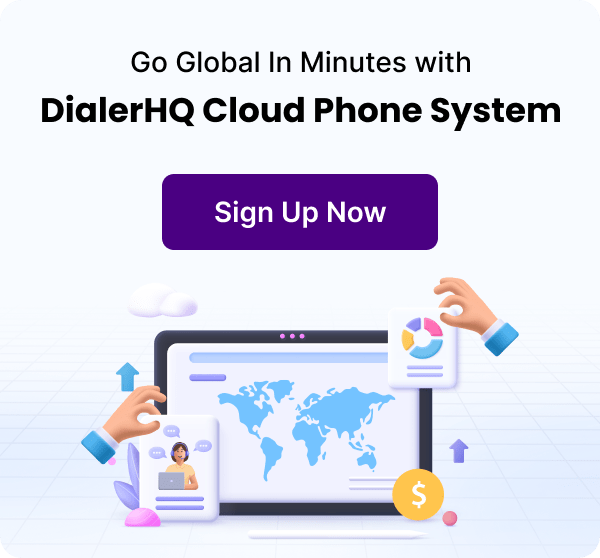Senior Writer: Rohit Rajpal
Call quality monitoring is one of the most critical aspects of call center quality assurance. While 93% of customers expect their calls to be resolved on the first call, monitoring the quality of your calls can constantly help you upgrade the standards of your customer service.
In this article, we will explore how call quality monitoring can ensure that you are meeting your compliance goals. We will also go through the best practices for improving your call quality monitoring process.
What is Call Quality Monitoring and Why is it Important?
Call quality monitoring enables businesses to evaluate and assess the interactions between call center agents and customers. This process provides actionable feedback to identify areas of improvement in your call center. Additionally, it helps maintain service standards, ensure regulatory compliance, and elevate customer satisfaction.
Call quality monitoring is a continuous process. Regularly monitor and evaluate customer service provided by your call center and adapt an improvising approach to stay ahead of the curve. By using virtual cloud phone software like DialerHQ for call quality monitoring, you can ensure your call center delivers exceptional customer experiences.
The process does not only involve recording your calls and monitoring them randomly. Rather, it is a multifaceted practice that encompasses reviewing the most important attributes of a quality call, such as listening skills, speaking speed, tone of voice, emotional intelligence, correct use of script, meeting customer expectations, professionalism, etc. Moreover, it provides you with real insights into what interactions are actually happening between your employees and your customers.
What are the Benefits of Call Quality Monitoring?
By using advanced call center quality monitoring software, you can render various benefits to improve the overall performance of your call center.

Let’s have a look at some of its top advantages in detail.
1. Fosters Customer Satisfaction
Call quality monitoring tools can aid in providing better customer experiences by meticulously evaluating the current standards of your customer service. Moreover, knowing that “the call is being recorded for quality purposes”, customers can rest assured they will receive the right support in the right way, heightening their overall experience.
2. Ensures Regulatory Adherence
Regulatory adherence is essential for call centers to ensure compliance with laws and regulations governing customer interactions, data privacy, and telemarketing practices. Failure to comply with these regulations may lead to legal consequences and financial penalties. A quality monitoring call center mitigates these risks along with the reputational damage associated with it.
3. Targeted Coaching and Training
By scrutinizing the nuances of call observations, call center managers can provide detailed and personalized feedback to the agents.

It provides exact details about what’s holding your agents back from providing top-notch solutions. Depending on that, agents can be trained to develop problem-solving skills, effective communication, etc. Likewise, you can also identify the areas your agents excel in.
4. Realistic Goal Setting
Setting realistic goals helps you achieve sustainable growth. By analyzing call quality metrics and identifying areas for improvement, the call quality monitoring process enables managers to establish achievable and data-driven performance targets. The performance indicators can aid in setting realistic goals that are aligned with the standards and objectives of the call center.
How do You Monitor Quality in a Call Center?
The basics of monitoring a call include recording inbound and outbound calls and analyzing the performance metrics associated with them. This can be done with the help of CRM tools and dialer systems, which record phone calls and score them based on the resolutions provided by the agent.
But modern call monitoring practices demand deploying a call center quality monitoring software that goes a step forward from basic recording. Such software takes into account a wide range of factors to provide you with full visibility over your calls. Let’s now discuss various methods for monitoring the quality of your calls.
Effective Methods for Monitoring Call Quality
Irrespective of the type of business involved, every customer wants their concerns to be solved effortlessly and at the earliest. According to studies, 50% of customers take their business elsewhere after just one bad experience.

Therefore, continuous monitoring of the key performance indicators has become more important than ever, and the use of call quality monitoring tools holds paramount importance.
1. Call Recording
Quite obvious yet indispensable for call center quality assurance. Recording the conversations taking place between your agents and customers will not only help you review the agent performance but will also provide a fair idea of customer satisfaction.
2. Live Call Monitoring
Call center quality monitoring software enables managers and supervisors to listen to live phone calls through features like call barging or call whispering. Hence, agents can receive immediate feedback and suggestions regarding their performance.
3. Creating Scorecards
Create call quality monitoring forms or scorecards by including specific factors such as soft skills, problem resolution, adherence to script, compliance or non-compliance with the business SOPs, customer response, call handling time, etc. These call quality monitoring forms will help the QA team systematically evaluate the agent’s performance.

4. Customer Feedback
Have you ever talked to a customer service agent? Then, you are most likely familiar with a message or email that lands in our inboxes asking you to rate the customer service experience that was provided to you. Asking customers to provide direct feedback helps gauge the call center’s performance from your customer’s point of view.
5. Data Analysis
By comprehensively tracking and monitoring key performance indicators, you can derive deeper insights into agent performance and customer experience. It also helps in optimizing the process, identifying trends, and making informed decisions.
Call Quality Monitoring Best Practices
Most customer care centers these days follow some or another kind of quality monitoring procedure, but if done correctly, call quality monitoring best practices can help you deliver unparalleled customer service by deciphering the areas for improvement in your call center.

If you are looking for ways to improve your call center performance, here are seven things you need to implement today.
1. Record and Monitor All Your Calls
To perform call monitoring in the right way from the start, make sure 100% of your calls are being monitored. Analyzing randomly selected phone calls will only result in guesswork about the overall performance of your call center. The fact that sample selection in almost every call center is random is one of the main reasons for misleading interpretations.
It often catches a few below-average calls while ignoring many instances of successful encounters by an agent. Monitoring the interactions day in and day out provides a crystal-clear picture to the call center managers, allowing them to modify the process by accurately identifying the bottlenecks.
2. Develop a Quality Assurance Team
Establishing a dedicated quality assurance team equipped with members who are experts in meticulously evaluating call interactions and identifying areas for improvement is crucial in fortifying the call quality monitoring framework. Making a team consisting of managers, supervisors, and a few top agents who are familiar with your business inside and out will reduce the workload and make the monitoring task easier.

This team serves as a vanguard of quality excellence, ensuring that customer interactions align with predefined standards and contribute to the objectives of the business. Alternatively, you can also hire a third-party team for an unbiased evaluation.
3. Involve Your Agents in the Call Monitoring Process
Empower your call center agents to contribute to the quality improvement process by involving them in the process. Ask the quality assurance team to share their views on the call monitoring workflows. This inclusive strategy cultivates a sense of ownership and promotes a collaborative approach to quality improvement.

It can also be done by allowing a few top-performing agents to monitor customer service calls and fill out the call quality monitoring forms. They are the ones who better understand the benchmarks and can help other agents upgrade their performance by giving factual reviews.
Modern call center quality monitoring software allows you to provide dashboard access to authorized people. Sharing the dashboard access with teams and individual agents keeps everyone in the loop, enabling them to monitor the key performance metrics, customer feedback trends, areas of improvement, etc.
It also promotes transparency and visibility, the key factors involved in fostering a culture of quality excellence. And by continuously monitoring and speculating these performance indicators, the team will be able to actively contribute to the enhancement of customer interactions.
5. Provide Proactive Agent Training for Improvement
Once you have implemented good call center quality monitoring software and have some of the most prominent call quality monitoring tools to record and listen to your agent interactions, next comes providing timely performance-based feedback. It helps identify each agent’s area for improvement and understand their strengths, based on which managers can create targeted training programs.

If you notice that the customers are not being greeted properly or that they aren’t being asked specific questions to understand the problem quickly, you can create training programs that cover these concerns. Focus more on industry-specific nuances and solution-driven communication during the training to elevate the caliber of customer engagements.
6. Provide Positive Feedback to the Agents
Rewarding agents for following call quality monitoring best practices is a great way to improve performance through positive reinforcement. Acknowledging and celebrating exemplary performance instead of pinpointing poor performance publicly motivates agents to consistently deliver exceptional customer experiences.

Did the agent adhere to all calling protocols? Did the agent excel at calming down a frustrated customer? Focus on recognizing and appreciating the outstanding efforts to foster a positive and empowering work environment. This will also make your agents more open to receiving constructive feedback on their scope for improvement. You can also practice rewarding incentives or certificates such as “star performers” or “rising stars”.
7. Optimize your call center monitoring process regularly
Monitoring call quality and improving customer experience is an ever-evolving process. Make changes in these processes as needed to ensure that they align with the goals and priorities of your business. Embrace a culture of continuous improvement by optimizing the call center monitoring process regularly.
You May Also Read : What is Call Center Monitoring and Why is it Important?
Make the best use of insights derived from data analytics, customer feedback, and performance evaluations to refine monitoring methodologies, enhance operational agility, and drive sustained excellence in customer interactions.
Wrapping Up
Your call center agents represent your company by dealing with your customers regularly. Call center monitoring is paramount in the pursuit of excellence in customer satisfaction. Using effective call quality monitoring tools and implementing the best practices mentioned above can help you enhance overall performance and provide better customer service.
Frequently Asked Questions
The call quality monitoring process involves recording your client-agent interactions and monitoring and assessing them on a regular basis to identify areas for improvement in call centers and to enhance the customer experience.
Call center quality can be measured with the help of call center monitoring software. It offers various key indicators of the call center's performance. Additionally, it can also be done by forming quality assurance teams, creating call quality monitoring forms, and seeking customer feedback.
Nowadays, call centers commonly use effective call quality monitoring tools like call monitoring software, call recording software, speech analytics software, customer feedback surveys, etc., to drive operational excellence.
Rohit Rajpal simplifies intricate technical ideas into practical insights through his articles and publications. His journey in VoIP and cloud telephony reflects a profound grasp of the evolving landscape, a flair for innovation, and a dedication to creating user-friendly blogs. Rohit’s broad expertise encompasses VoIP protocols, codecs, and cloud-based telephony systems, ensuring accessible knowledge for all.
Updated : March 22, 2024

Subscribe to our newsletter & never miss our latest news and promotions.





